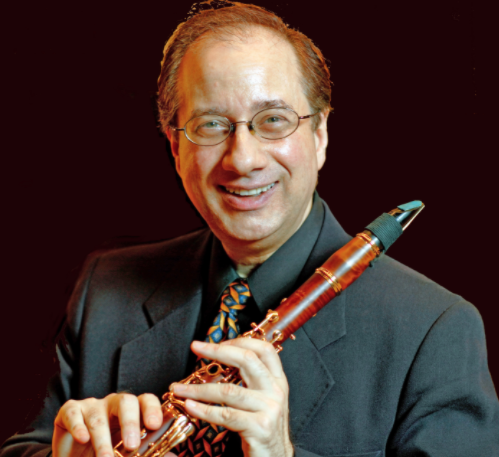Wa Concert Series presents The Golden Triangle: Prague, Budapest and Vienna in Review
Charles Neidich, artistic director, C and A clarinets; Ayako Oshima, C clarinet;
Parker Quartet: Daniel Chong, Ken Hamao, violin; Jessica Bodner, viola; Kee-Hyun Kim, cello
Tenri Cultural Institute, New York, NY
March 30, 2019
The beginning of the baseball season seems an apt time for this metaphor: The Wa Concert Series hit another home run in its already estimable string of them last night. The Parker Quartet (Daniel Chong, Ken Hamao, violin; Jessica Bodner, viola; Kee-Hyun Kim, cello ) joined clarinetists Charles Neidich and Ayako Oshima in concert. The general theme of Central Europe was the pretext for a wide variety of expression through music.
The curtain-raiser, so to speak (Tenri does not have a curtain), was Bohuslav Martinů’s Serenade for two clarinets and string trio, a 1951 work from his American period that Mr. Neidich stated was also influenced by sojourns in Paris and New York. This was not always apparent. One thing that is always reliable is the high level of craftsmanship of Martinů’s work. For me, his expressivity lies in his slow movements, while the quicker ones can sometimes feel a bit like they are on autopilot, despite the interesting rhythmic difficulties. The piece was played masterfully by Mr. Neidich, Ms. Oshima, and three members of the Parker Quartet.
The complete Parker Quartet followed the Martinů with a beautiful performance of György Kurtág’s Officium breve, in memoriam Andreae Szervanszky, a double-requiem (without words of course) for his colleague, Hungarian composer/clarinetist Endre Szervanszky, and their Austrian serialist predecessor, Anton Webern. It also memorializes cellist Tibor Turcsányi, recorder player Zsolt Baranyai, close friend Gabriella Garzó, and pianist György Szoltsányi. The fifteen minuscule movements have maximal expressive power, and the Parker Quartet’s perfection of style and intonation allowed even the uninitiated listener to share in the sense of sorrow; Kurtág, still active at 93, was a mentor to the group. Kurtág is here fascinated with the procedure known as canon (so important to Webern as well), and he utilizes references to Webern’s final work, the Kantate No. 2, Op. 31, a setting of six poems by Hildegard Jone that are mystical in content, and which Webern himself saw as a Missa brevis (Officium breve). Kurtág also self-quotes from his piano cycle Játékok, “Hommage à Szervánszky,” and song cycle The sayings of Péter Bornemisza, “Flowers we are,” and he quotes Szervanszky’s Serenade for String Orchestra. The audience held its applause for quite some time after the ending, always a good sign that the intensity of attention being paid was great.
After intermission, Mr. Neidich took the stage, again with the Parker Quartet, for a shattering, expressive performance of a repertoire staple, the Brahms Quintet for clarinet and string quartet in B minor, Op. 115, a work written from the heart and addressed to the heart. Thank goodness Brahms didn’t retire from composition, as he had announced after his Op. 111; he drew new inspiration from hearing the great clarinetist Richard Mühlfeld (Brahms gave him the nickname Fräulein Klarinette), and he created a beloved series of chamber works including the instrument (as well as piano pieces and Lieder), in which he further cemented his “late style”—every note is related organically to every other note, every motif recurs and interpenetrates, and there is in the quintet cyclic reference also (music from an earlier movement recurs).
That five musicians functioned as one would be the greatest understatement of my writing career. Sometimes in this work one hears a “diva” clarinet way out in front and four “others” supporting. Not so on this occasion! Every breath, every color, every phrase taper, was absolutely unanimous, yet always managed to sound completely “lived,” never over-planned. I could go on and on about Mr. Neidich, one of the greatest clarinetists in the world, but the Parker Quartet here matched him for inspiration: they made the hearty, warm Romantic sound so essential to this composer. I was particularly drawn to the cello work of Kee-Hyun Kim, so expressive, and his interplay with the other members. Also wonderful was the violist, Jessica Bodner. I don’t mean to neglect the violins either, but everyone knows the inner voices are more interesting!
The sense of leave-taking was palpable in the Brahms, and I can’t imagine there was a dry eye in the house (another long pause before clapping); they were brought back for four bows, but of course there is no “encore” possible after such a journey. I was ruminating on a line from the Hildegarde Jone poem: “By holy love’s great power.” As Mr. Neidich explained, there are references to the “Clara” theme (Clara Schumann, perhaps Brahms’ greatest unconsummated love), and even J.S. Bach. Thank goodness there was no Prozac in the nineteenth century!
By the way, the excellent dinner, included with one’s ticket and handmade by the multitalented Ayako Oshima , included two of Brahms’ favorites: sardines and chicken paprikash. Anyone who hasn’t attended a Wa concert, what are you waiting for? Two remain in this season.

